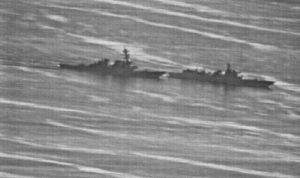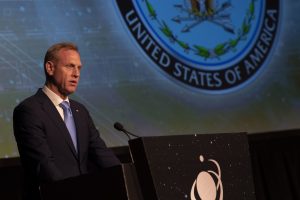
Chinese destroyer Lanzhou pulls in front of USS Decatur in the South China Sea. China illegally claims much of the sea.
This weekend’s Shangri La Dialogue looks to be very different from years past, as Acting Defense Secretary Patrick Shanahan is expected to unveil a new American Indo-Pacific Defense Strategy following months of increasingly assertive U.S. statements and actions regarding the People’s Republic of China.
In fact, we could see the most direct U.S. challenge to China since 2005, when Defense Secretary Rumsfeld became the proverbial skunk at the globalist garden party in Singapore by bluntly chastising the Chinese for what was then only the very beginning of their military modernization program.
That new Indo-Pacific strategy is expected to combine traditional themes of commitment and cooperation with a more explicit acknowledgement of the challenge posed by China as a military competitor. There to listen and react is expected to be the Chinese defense minister, appearing at the International Institute for Strategic Studies’ event for the first time in several years.
The strategy will highlight the American military modernization efforts most applicable to Asia scenarios, along with initiatives to help the U.S. integrate better with allies and – as importantly – enable allies and partners to better operate with each other. This does not mean reverting to America’s traditional role as chief organizer, facilitator and guardian of other Asian nations (the traditional “hubs and spokes” model that has prevailed since World War II). Instead, these countries will be expected to do more to defend themselves instead of relying passively on U.S. security guarantees (preferably, of course, using weapons and equipment made by American workers).
This will mark a shift in tone and substance for the annual Asia security conference, which has taken on a ritualistic quality in recent years. Assertions of U.S. recommitment to the region as a Pacific Nation (now “Indo-Pacific Nation”) and “resident power”; calls for more regional cooperation and partnership; condemnation of the latest North Korean outrage; boilerplate references to maintaining the status quo on Taiwan; and heavily vetted and exhaustively-interagency coordinated language encouraging the People’s Republic of China to be a positive force (“responsible global stakeholder”) while gently chiding the PRC for its latest infraction – or “self-exclusion” as one speech put it – of the liberal rules-based international order.
This all takes place in the context of a framework established by last year’s National Defense Strategy. The NDS prioritized “Great Power Competition” and the Trump Administration later designated the People’s Republic of China – with Russia as dangerous but dysfunctional runner-up – as the principal competitor driving U.S. defense planning and modernization priorities (or, as Patrick Shanahan reportedly told his staff after becoming Acting Secdef, it’s now “China, China, China.”).

Acting Secretary of Defense Pat Shanahan at the Space Symposium
The fiscal 2020 budget request for the Defense Department put some teeth and dollars behind the NDS, with substantive increases for high-tech research, development and procurement geared toward near-peer conflict. One sign of a more assertive U.S. posture: over a recent nine-month stretch U.S. Navy ships made six Freedom of Navigations trips through the Taiwan Strait in the face of bitter Chinese criticism (the Obama Administration averaged between one and three per year).
The most consequential American defense shifts for Asia – in the form of stand-off weapons, basing agreements, bi- and multi-lateral arrangements and unit deployments will unfold over time, depending in large part on the priorities of the next administration (be it elected or re-elected). In the shorter term, the U.S. can tangibly and swiftly demonstrate its Asia commitment – that, this time, we really do mean it – by building the defense capabilities meeting the most immediate military equipping needs of countries most vulnerable to Chinese coercion.
Looming in the background of Shangri La will be a pending sale of American made F-16s – first requested by Taiwan in 2005. U.S. defense and diplomatic officials have indicated that – after 14 years of delays and Chinese warnings – it’s finally going to happen. A Taiwan request for M-1 tanks is also in the works. But the Foreign Military Sales (FMS) process – requiring ascent from multiple agencies and Congress – can be a hazardous obstacle course.
Clearing through the FMS backlog and dealing with low hanging fruit – like replacing ageing combat platforms of the most vulnerable states – is an important first step. It may be time to incorporate regional partners into a defensive-oriented posture that complements America’s anti-access/area-denial capabilities in the Indo-Pacific. As a general matter, these nations are not seeking to project power offensively (nor should they). Instead, they need more options: ISR, drones, mines, anti-ship missiles, short-range air defense, rocket artillery, and non-kinetic cyber, jamming, and other electronic warfare tools. Those need not be exquisite and expensive U.S. systems. But these systems can help thwart or at least raise the cost of Chinese encroachment, including non-kinetic Gray Zone operations designed to avoid open conflict that could trigger treaty obligations and a potential U.S. military response. These nations must also show a willingness to spend more on their own defense – a deal breaker in the eyes of this White House. (Think of President Trump’s open frustration with NATO members). But they must also make internal structural changes such as hardening and dispersing critical military assets. Those shiny new F-16s will do Taiwan little good if they are obliterated on the runway by a PLA missile barrage in the first hour.
These kinds of capabilities pose virtually no offensive threat to China. The F-16s – unlike the stealthy F-35s that Taiwan sought at one point – would be unable to overcome the PLA’s most sophisticated air defenses and fighter aircraft. Yet it is almost certain that the Chinese will categorize this sale as a gross provocation. But concerns over PRC retaliation are giving way increasingly to an emerging bi-partisan consensus that mollifying China – on everything from trade to Tibet – has only prompted more of the same – or worse.
Fourteen years after Rumsfeld chastised the Chinese defense build-up (augmented by espionage and the unwitting collaboration of many Western corporations and universities) it has narrowed, if not closed, the gap with the U.S. in important defense technology areas. The military balance of power has been altered profoundly along the First Island Chain that stretch from the Japanese home islands to Taiwan. Uninhabited – though contested – Islands in the South China Sea have been turned into launching pads for the People’s Liberation Army
So a potential historic inflection point is possible, one when America begin to turn the tide, literally and figuratively, against Chinese coercion and expansion in the region. That will, of course, depend on tangible actions that follow – money spent, forces deployed, risks shared – by the U.S. and its long-standing allies and newer partners.
Because even a well-received Shangri La speech and policy roll-out will amount to little if the U.S. shifts are not taken seriously by countries in the region. And, well, they have heard versions of it before.
For most of the 2000s a staple of U.S. policy messaging and Shangri La speeches was reassurance – with decreasing plausibility as military deployments to Iraq and Afghanistan increased – that the post-9/11 military campaigns in no way lessened our security commitments and focus in Asia.
The Obama Administration’s Pacific Pivot was announced in 2012 – changed later to “rebalance” to soothe nervous Europeans and offended Chinese– was effectively stillborn. Soon after the Arab Spring turned to bloody chaos, ISIS took over much of western Iraq, and Budget Control Act-driven defense cuts gutted defense modernization and readiness accounts, precluding major American military plus-up in the region. In this respect, last week’s troop and carrier deployments directed at Iran provide another unhelpful Michael Corleone moment for the U.S. as it tries (again) to disentangle from the Middle East and focus on Asia, a desire dating back to the early years of the Iraq war
So when the bleary-eyed American delegation departs Singapore in a few days, the hard work of turning the new Indo-Pacific defense strategy into an enduring shift in regional dynamics will lie ahead. It will take place against a backdrop of U.S.-China security relations that have already turned more combative – and may become more confrontational yet. But necessarily so, as America comes to terms of what it means to be a truly Pacific Nation in an age of Great Power competition.
Thayer Scott is a communications consultant and former chief speechwriter for Secretary of Defense Robert Gates.
Connecticut lawmakers to grill Army, Lockheed about job cuts at Sikorsky helicopter unit
“The Connecticut delegation has questions about why, with that [FY24] appropriation in hand, this happened,” said Rep. Joe Courtney, D-Conn.


























